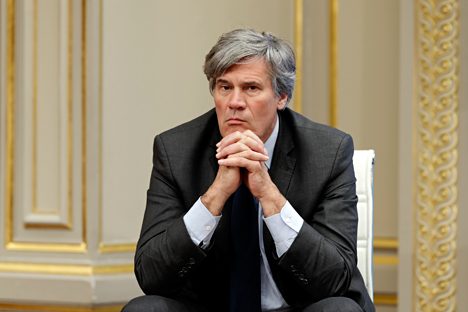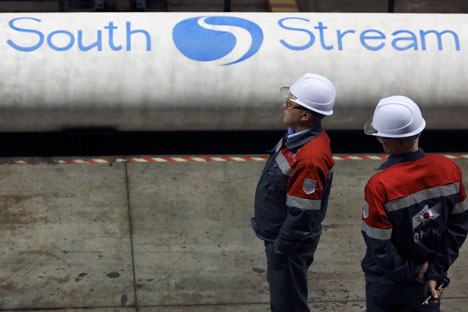Life after sanctions: What kind of future awaits Russia and the EU?

Drawing by Dmitry Divin
The talk about the possible lifting of sanctions against Russia this year is growing louder across Europe, with the traditionally amicable countries like Italy or Austria seeming to have now been joined by France. Experts are beginning to discuss what future relations with Moscow could look like.
So let’s take a look at the data: Legally speaking, EU-Russia relations are based on the Partnership and Cooperation Agreement (PCA), signed in 1994. This is a comprehensive and extremely detailed document that regulates the various aspects of cooperation, proclaiming the “strategic partnership” as the political goal.
The ideological basis for the PCA is the idea of a “Greater Europe,” which is basically a codex of common rules and values being formed around the European Union. Russia was considered (and, back then, was willing to accept itself as) a recipient of a regulatory framework, rather than an equal creator of a new system.
The mid-2000s saw the parties begin discussions on drafting a new baseline agreement instead of the PCA, which was originally due to expire. The next agreement was supposed to take into consideration the cooperation experience accumulated by that point, laying the foundation for a further, proper rapprochement. That said, the political climate had begun changing by then.
Relations have indeed reached a new level, but in a downward direction, rather than an upward one.
As the result, after the crisis in Ukraine erupted and began escalating rapidly, both parties introduced sanctions against each other. Thus the era of the proclaimed “strategic partnership” was over, leaving an unpleasant aftertaste on both sides.
The return to the old model – even if we assume the extremely unlikely scenario of a smooth settling of the Ukrainian crisis – is not going to happen. To put it simply, Russia no longer wants to be a part of a united Europe, while the united Europe is tired of expanding and is trying to turn inward to resolve its numerous internal conflicts.
We should designate a few basic parameters that are necessary to get a rough estimate of future EU-Russia relations.
There will be no Greater Europe
The “strategic partnership” modeled after the relations of the 1990s and 2000s is impossible to restore. The idea of a “Greater Europe” is no longer relevant. After the current crisis ends, relations will no longer be all-encompassing, and will most likely focus on certain practical aspects. In fact, Russia had started offering such an option long before the Ukrainian crisis.
The notion of “common values” will probably grow out of use, both because these values are contested by Russia, and we could soon see a shift of values in the EU since it needs to reconsider its integration model. The migrant problem is already working as a catalyst in this issue.
Cooperation will be pragmatic
There are some practical aspects within EU-Russia relations that cannot be ignored whatever the political climate. These are energy (these ties will not break for at least a couple of decades), the movement of people (this issue has now become much more important, what with the refugee problem), and the development of neighboring territories (cross-border cooperation, the need to address common challenges, etc.).
Cooperation in each of these areas is possible, but there is no point in uniting it all into a single program and providing a legal basis for it, especially since Europe’s own legal base could change both under the influence of internal shifts, and because of the Transatlantic Trade and Investment Partnership that could be concluded between the EU and the United States.
The creation of a ‘Greater Eurasia’
The question of future economic development is now much more relevant not for the idea of a “Greater Europe,” which did not really work out, but rather for a “Greater Eurasia.” The main reason for this is of an external nature: China has turned to the West and is very serious about creating a link to Europe and the Mediterranean.
The EU-Russia format is useless for creating a “Greater Eurasia.” This task requires a multifaceted approach, discussions between the EU and the Eurasian Economic Union, the EAEU and China, the EU and China and finally, China, the EAEU and the EU.
This latter format is the one in which the things previously discussed by Moscow and Brussels – including the creation of a common economic space and the coordination of rules and regulations – should be examined now. There is at least one possible advantage to this approach: The countries that have hovered between different integration projects and are becoming a field for pointless competition or unnecessary liabilities will have a chance to solve their problems this way. We are talking about some of the former Soviet republics that still have not found a stable development basis.
European insecurity
The notion of “European security” has changed drastically, and not just because of Ukraine or certain other countries where Russia and the EU or NATO collide, whether these conflicts are imaginary or real.
Europe as a whole is no longer a place of guaranteed stability. On one hand, this is due to the fact that the EU cannot and will not be able to dissociate itself from the increasingly dangerous blunders of the Middle East. On the other hand, the project’s accumulated lack of balance at home is leading to the dismantling of the uniting mechanism (the Schengen Area does not stand a chance in its current form, it seems), further deepening the contradictions between the member states.
South-eastern Europe, particularly the Balkans, is the most dangerous area in this respect, since the crisis of the European ideology there could result in the seemingly forgotten conflicts of the recent past flaring up again.
The migrants, again, are a powerful catalyst here. Central Europe, which is increasingly unanimous in opposing Berlin and demanding that Germany resolve the whole refugee issue alone, virtually without any support from other European countries, could well turn from the main apologist of the EU project into its main critic.
Moreover, in the worst-case scenario, the shaky situation in the “Eastern Partnership” countries, overlapping with the unrest in Central and Eastern Europe, could lead to the recreation of the competition for the “Intermediate Europe,” which resulted in two great wars back in the 20th century.
First published in Russian in Gazeta.ru.
Russia's political achievements in Syria eclipse modest military success>>>
All rights reserved by Rossiyskaya Gazeta.
Subscribe
to our newsletter!
Get the week's best stories straight to your inbox

